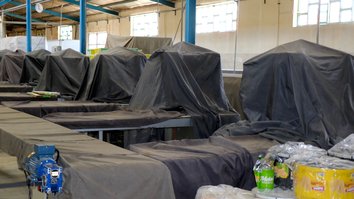HELMAND -- Once the winter residence of sultans from illustrious Islamic dynasties, the ruins of a thousand-year-old royal city in Helmand province have become home to hundreds of Afghans who have fled Taliban violence.
The astonishing ochre clay complex juts from the cliffs along the Helmand River, threatened by decay and encroaching urban sprawl as well as the makeshift constructions that have grown within it.
Thousands of Afghans have been displaced across Helmand since October following a surge in Taliban attacks, and while many have resettled in the capital Lashkargah -- which remains under government control -- some have joined other internally displaced persons in the ruins.
Qala-e-Kohna, as it is known locally, or Lashkari Bazar to archaeologists, has garnered international attention for its scale, remarkable architecture and murals.
![Internally displaced Afghan men walk along a pathway of an old palace at the historic site of Qala-e-Kohna, where they live with other families in Lashkargah, Helmand province, on March 27. [Wakil Kohsar/AFP]](/cnmi_pf/images/2021/05/31/30055-000_97e9mr-585_329.jpg)
Internally displaced Afghan men walk along a pathway of an old palace at the historic site of Qala-e-Kohna, where they live with other families in Lashkargah, Helmand province, on March 27. [Wakil Kohsar/AFP]
Spread over 10km, the site is the only known winter residence of the Ghaznavid and Ghurid sultans -- two dynasties that ruled a region covering present-day Afghanistan between the 10th and 13th centuries and responsible for spreading Islamic art as far as north India.
"There is no place in the Islamic world where we have something like it -- a site as coherent, elaborate and despite everything still relatively well preserved," said Philippe Marquis, the director of the French Archaeological Delegation in Afghanistan (DAFA).
"It is important to preserve it because we are sure that it will teach us a lot about this period," he told AFP.
Fleeing Taliban violence
Among the ancient towers, residents have added doors and windows and have coated crumbling walls with a clay-and-straw mixture to strengthen them and plug gaps.
A blue wrought-iron door leads into Agha Mohammad's cramped two-room quarters that house 11 people, a makeshift cradle for his infant son hanging from a bamboo roof.
"Look at the cracks in the roof," he said. "I'm afraid one night it will fall."
Southern Afghanistan has seen renewed fighting as peace talks between the Afghan government and Taliban leaders have stalled, and US and NATO forces are withdrawing the last of their troops from the country by September 11.
The Taliban have used the presence of foreign forces to justify their ongoing war, but despite the drawdown progressing as planned, the militants have continued to destroy infrastructure projects and carry out attacks against civilians and Afghan National Defence and Security Forces (ANDSF).
In recent weeks, the Taliban have attempted to take over Helmand, Kandahar, Baghlan, Herat, Farah and Ghazni provinces, Fawad Aman, a Defence Ministry spokesman, said May 17.
Not only did they fail to capture any major city or province, he said, but they sustained heavy casualties, as the ANDSF killed more than 1,000 Taliban fighters, commanders and key members.
Many of the residents of Qala-e-Kohna are from police families.
"I have sacrificed three sons for this government," said 48-year-old Bibi Halima.
"The Taliban seized our house, so we live here, and I have only one younger son," she said.
"Every house is full of widows," added a neighbour.
Khudai Nazar, 54, called on the government to bring electricity to families living among the ruins.
"We were displaced by the fighting; our area is still under Taliban control," he said, adding that every family living at the site has lost members to Taliban violence.
"We cannot return to our area," he said. "We have been living here because we are helpless."
Preserving the site
First explored by DAFA in the 1950s, the site has seen no conservation work since then.
At that time, archaeologists identified the palaces, a mosque and other annex buildings, such as pottery and craft workshops, as well as ice boxes used for the preservation of fresh food.
One of the most striking excavations was a series of paintings depicting court scenes, extremely rare for an era in which the realistic representation of living beings was already frowned upon in Islamic societies.
Moved to the Kabul museum, the paintings were destroyed or stolen during the Afghan civil war in the 1990s. Only photographs remain.
DAFA director Marquis is now concerned about the impact of global warming, which could cause the river to flood.
On the one hand, reinforcements made from clay and straw that the new residents have added to the partly collapsed towers may have also resulted in their temporary preservation.
"In their own way people are protecting the place because it is their home," Marquis said.
He proposes building an "archaeological park" that involves displaced Afghans in the conservation process so they can earn a living and settle outside the palace walls.
But for Shah Mahmud Hasrat, who has written a book about the citadel, the future of the largely unexplored ruins remains uncertain.
"We are really afraid that our history will be destroyed," he said, calling on the government to protect the site.
"The Bost historical castle is so important for Helmand residents; it has over 3,000 years of history," he said, likening the castle to "a holy shrine".
"If the government allowed them, then I'm sure every Friday thousands of people would visit there."

![Men walk along a pathway near an old palace at Qala-e-Kohna, a historic site in Lashkargah, the capital of Helmand province, on March 27. [Wakil Kohsar/AFP]](/cnmi_pf/images/2021/05/31/30054-000_97e9mz-585_329.jpg)
![An arch of the historic fortress of Qala-e-Bost is seen in Bost on the outskirts of Lashkargah, Helmand province, on March 27. [Wakil Kohsar/AFP]](/cnmi_pf/images/2021/05/31/30056-000_97e9n7-585_329.jpg)
![An internally displaced Afghan woman walks toward her home at the historic site of Qala-e-Kohna in Lashkargah, Helmand province, on March 27. [Wakil Kohsar/AFP]](/cnmi_pf/images/2021/05/31/30057-000_97e9mj-585_329.jpg)
![An internally displaced Afghan man and children stand inside the ruins of a palace where they live along with other families at Qala-e-Kohna, a historic site in Lashkargah, Helmand province, on March 27. [Wakil Kohsar/AFP]](/cnmi_pf/images/2021/05/31/30058-000_97e9n3-585_329.jpg)
![Internally displaced Afghan children walk among ruins of a palace where they live with their families at the historic site of Qala-e-Kohna on March 27. [Wakil Kohsar/AFP]](/cnmi_pf/images/2021/05/31/30059-000_97e9mn-585_329.jpg)
![The ruins of a palace are pictured near the historic fortress of Qala-e-Bost in Bost on the outskirts of Lashkargah, Helmand province, on March 27. [Wakil Kohsar/AFP]](/cnmi_pf/images/2021/05/31/30060-000_97e9mx-585_329.jpg)
![An internally displaced Afghan man rests inside the ruins of a palace where internally displaced families live at the historic site of Qala-e-Kohna in Lashkargah, the capital of Helmand province, on March 27. [Wakil Kohsar/AFP]](/cnmi_pf/images/2021/05/31/30061-000_97e9mq-585_329.jpg)
![Internally displaced Afghan children walk inside the ruins of a palace where they live with their families at the historic site of Qala-e-Kohna in Lashkargah, Helmand province, on March 27. [Wakil Kohsar/AFP]](/cnmi_pf/images/2021/05/31/30062-000_97e9my-585_329.jpg)
![A man and a boy walk along a pathway near an old palace were internally displaced families live at Qala-e-Kohna, a historic site in Lashkargah, Helmand province, on March 27. [Wakil Kohsar/AFP]](/cnmi_pf/images/2021/05/31/30063-000_97e9n2-585_329.jpg)
![Internally displaced Afghan men and boys walk along the wall of a palace where they live along with other families at the historic site of Qala-e-Kohna in Lashkargah, the capital of Helmand province, on March 27. [Wakil Kohsar/AFP]](/cnmi_pf/images/2021/05/31/30064-000_97e9mm-585_329.jpg)
![The ruins of a palace near the historic fortress of Qala-e-Bost are seen in Bost on the outskirts of Lashkargah, Helmand province, on March 27. [Wakil Kohsar/AFP]](/cnmi_pf/images/2021/05/31/30065-000_97e9mt-585_329.jpg)
![Men walk at the historic fortress of Qala-e-Bost on the outskirts of Lashkargah, Helmand province, on March 27. [Wakil Kohsar/AFP]](/cnmi_pf/images/2021/05/31/30066-000_97e9n6-585_329.jpg)






